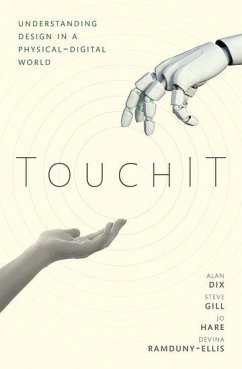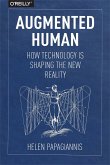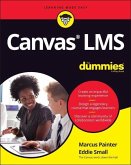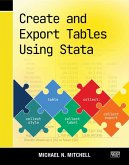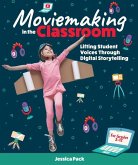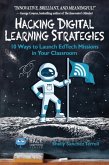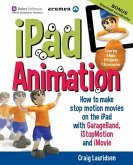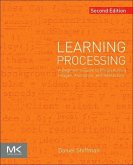Alan Dix (Professor and Director and Professor Director and Direct, Steve Gill (Professor and Deputy Director of Research & Graduate St, Devina Ramduny-Ellis (Director of Education and Head of Computer Sc
Touchit
Understanding Design in a Physical-Digital World
Alan Dix (Professor and Director and Professor Director and Direct, Steve Gill (Professor and Deputy Director of Research & Graduate St, Devina Ramduny-Ellis (Director of Education and Head of Computer Sc
Touchit
Understanding Design in a Physical-Digital World
- Gebundenes Buch
- Merkliste
- Auf die Merkliste
- Bewerten Bewerten
- Teilen
- Produkt teilen
- Produkterinnerung
- Produkterinnerung
TouchIT brings together insights from human-computer interaction and industrial design, exploring these themes under four main headings: human body and mind; objects and things; space; and information and computation.
Andere Kunden interessierten sich auch für
![Augmented Human Augmented Human]() Helen PapagiannisAugmented Human39,99 €
Helen PapagiannisAugmented Human39,99 €![Canvas Lms for Dummies Canvas Lms for Dummies]() Marcus PainterCanvas Lms for Dummies22,99 €
Marcus PainterCanvas Lms for Dummies22,99 €![Create and Export Tables Using Stata Create and Export Tables Using Stata]() Michael N. MitchellCreate and Export Tables Using Stata103,99 €
Michael N. MitchellCreate and Export Tables Using Stata103,99 €![Moviemaking in the Classroom Moviemaking in the Classroom]() Jessica PeckMoviemaking in the Classroom35,99 €
Jessica PeckMoviemaking in the Classroom35,99 €![Hacking Digital Learning Strategies Hacking Digital Learning Strategies]() Shelly Sanchez TerrellHacking Digital Learning Strategies35,99 €
Shelly Sanchez TerrellHacking Digital Learning Strategies35,99 €![iPad Animation iPad Animation]() Craig LauridseniPad Animation43,99 €
Craig LauridseniPad Animation43,99 €![Learning Processing Learning Processing]() Daniel Shiffman (Tisch School of the Arts, New York University, NewLearning Processing56,99 €
Daniel Shiffman (Tisch School of the Arts, New York University, NewLearning Processing56,99 €-
-
-
TouchIT brings together insights from human-computer interaction and industrial design, exploring these themes under four main headings: human body and mind; objects and things; space; and information and computation.
Hinweis: Dieser Artikel kann nur an eine deutsche Lieferadresse ausgeliefert werden.
Hinweis: Dieser Artikel kann nur an eine deutsche Lieferadresse ausgeliefert werden.
Produktdetails
- Produktdetails
- Verlag: Oxford University Press
- Seitenzahl: 608
- Erscheinungstermin: 11. November 2022
- Englisch
- Abmessung: 191mm x 165mm x 18mm
- Gewicht: 782g
- ISBN-13: 9780198718581
- ISBN-10: 0198718586
- Artikelnr.: 60022797
- Herstellerkennzeichnung
- Libri GmbH
- Europaallee 1
- 36244 Bad Hersfeld
- gpsr@libri.de
- Verlag: Oxford University Press
- Seitenzahl: 608
- Erscheinungstermin: 11. November 2022
- Englisch
- Abmessung: 191mm x 165mm x 18mm
- Gewicht: 782g
- ISBN-13: 9780198718581
- ISBN-10: 0198718586
- Artikelnr.: 60022797
- Herstellerkennzeichnung
- Libri GmbH
- Europaallee 1
- 36244 Bad Hersfeld
- gpsr@libri.de
Alan Dix is a Professor and Director of the Computational Foundry at Swansea University, Wales, UK, a research centre built on the belief that addressing human needs and human values requires and inspires the deepest forms of fundamental science. Previously he spent 10 years in a mix of academic and commercial roles. Alan has worked in human-computer interaction research since the mid 1980s and is a member of the ACM SIGCHI Academy. He is the author of one of the major international textbooks on HCI as well as numerous research publications from formal methods to design creativity, including some of the earliest papers in the HCI literature on topics such as privacy, mobile interaction, and gender and ethnic bias in intelligent algorithms. Steve Gill is Director of Research and Professor of Interactive Product Design at Cardiff Metropolitan University, Wales, UK. He has around 80 publications including 3 patents, but 'Touch-IT' is his first book. While he has been an academic for well over two decades, Steve is, was and will always be an industrial designer at heart and his approach to academic research betrays that basic fact. Like all industrial designers Steve works across disciplines to deliver new approaches, which is essentially how he met Alan. He has a long-standing interest in applied human-centred design approaches with physicality at their core. In recent years these have led to collaborations with computer scientists, engineers, artists, architects and medics, resulting in involvement in projects as diverse as ultra-low cost trauma packs for sub-Saharan Africa and next generation VR. Devina Ramduny-Ellis is Director of Education and Head of Computer Science at Huddersfield Grammar School, UK. She is a computer scientist who worked for many years in Higher Education before moving to the secondary sector. As a researcher, she worked on multidisciplinary projects, with academic and industrial collaborators, covering a breadth of areas. She was actively involved in the research community and has a number of refereed publications for major conferences, journals and book chapters. For the past four years she taught Computer science to Key Stage 5 students at Greenhead College with great success by applying her own subject knowledge, problem-solving techniques and consulting existing analysis and research. Jo Hare is a Senior Lecturer and Programme Leader for the BA in Product Design at UWE, Bristol. The collaboration culminating in this book has provided the foundations of her academic career, having first met Steve, Alan and Devina as the Research Assistant for the Designing for Physicality project (DEPtH). Like Steve, human-centred design is at the core of Jo's work; starting with the use of ultra-low fidelity prototypes to understand user needs which led her to focus on human centred design research methods for the earliest stages of the design process. Service Design and Design Thinking now forms the basis of Jo's teaching and applied research, establishing the role real people play in the success of innovations, fostering a 'making things tangible' approach and applying creativity to complex projects.
1: Elements of our hybrid existence
2: What's Happening Now
3: Body
4: Mind
5: Body and Mind
6: Social, Organisational and Cultural
7: Physicality of Things
8: Interacting with Physical Objects
9: Hybrid Devices
10: Tools, Equipment, and Machines
11: Physicality of Space
12: Comprehension of Space
13: The Built Environment
14: Digital Augmentation of Space
15: Representation and Language
16: Reproducibility
17: Embodied Computation
18: Connecting physical and digital worlds
19: Design Lessons and Advice
20: Prototyping and Tool Support
21: Computational Modelling and Implementation
22: Theory and Philosophy of Physicality
2: What's Happening Now
3: Body
4: Mind
5: Body and Mind
6: Social, Organisational and Cultural
7: Physicality of Things
8: Interacting with Physical Objects
9: Hybrid Devices
10: Tools, Equipment, and Machines
11: Physicality of Space
12: Comprehension of Space
13: The Built Environment
14: Digital Augmentation of Space
15: Representation and Language
16: Reproducibility
17: Embodied Computation
18: Connecting physical and digital worlds
19: Design Lessons and Advice
20: Prototyping and Tool Support
21: Computational Modelling and Implementation
22: Theory and Philosophy of Physicality
1: Elements of our hybrid existence
2: What's Happening Now
3: Body
4: Mind
5: Body and Mind
6: Social, Organisational and Cultural
7: Physicality of Things
8: Interacting with Physical Objects
9: Hybrid Devices
10: Tools, Equipment, and Machines
11: Physicality of Space
12: Comprehension of Space
13: The Built Environment
14: Digital Augmentation of Space
15: Representation and Language
16: Reproducibility
17: Embodied Computation
18: Connecting physical and digital worlds
19: Design Lessons and Advice
20: Prototyping and Tool Support
21: Computational Modelling and Implementation
22: Theory and Philosophy of Physicality
2: What's Happening Now
3: Body
4: Mind
5: Body and Mind
6: Social, Organisational and Cultural
7: Physicality of Things
8: Interacting with Physical Objects
9: Hybrid Devices
10: Tools, Equipment, and Machines
11: Physicality of Space
12: Comprehension of Space
13: The Built Environment
14: Digital Augmentation of Space
15: Representation and Language
16: Reproducibility
17: Embodied Computation
18: Connecting physical and digital worlds
19: Design Lessons and Advice
20: Prototyping and Tool Support
21: Computational Modelling and Implementation
22: Theory and Philosophy of Physicality

